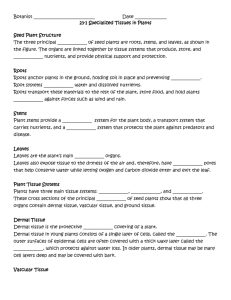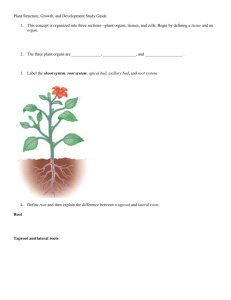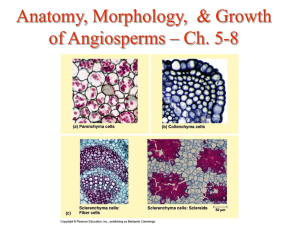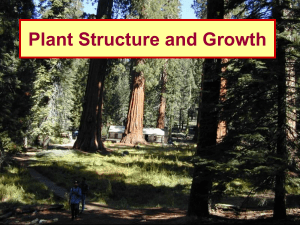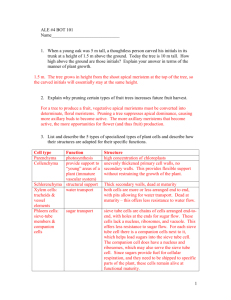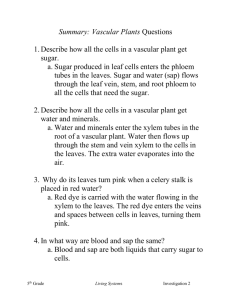Today: Plant Structure Outline – Plant structure Plant Cell Walls
advertisement
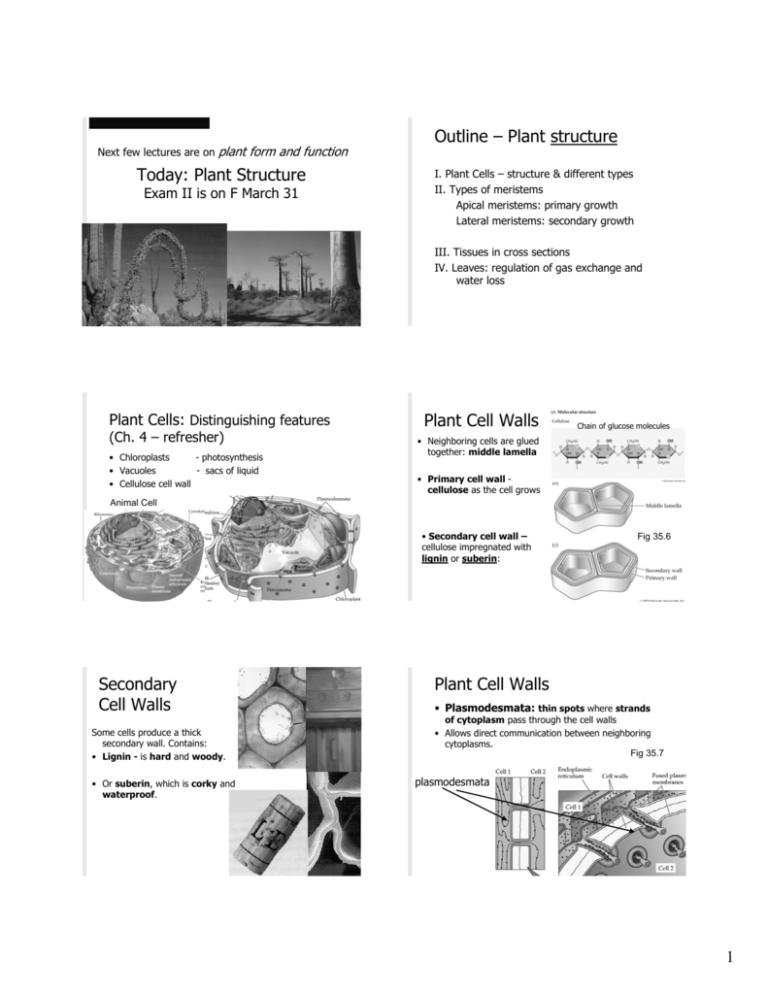
Next few lectures are on plant form and function Today: Plant Structure Exam II is on F March 31 Outline – Plant structure I. Plant Cells – structure & different types II. Types of meristems Apical meristems: primary growth Lateral meristems: secondary growth III. Tissues in cross sections IV. Leaves: regulation of gas exchange and water loss Plant Cells: Distinguishing features (Ch. 4 – refresher) • Chloroplasts - photosynthesis • Vacuoles - sacs of liquid • Cellulose cell wall Plant Cell Walls Chain of glucose molecules • Neighboring cells are glued together: middle lamella • Primary cell wall cellulose as the cell grows Animal Cell • Secondary cell wall – cellulose impregnated with lignin or suberin: Secondary Cell Walls Some cells produce a thick secondary wall. Contains: • Lignin - is hard and woody. • Or suberin, which is corky and waterproof. Fig 35.6 Plant Cell Walls • Plasmodesmata: thin spots where strands of cytoplasm pass through the cell walls • Allows direct communication between neighboring cytoplasms. Fig 35.7 plasmodesmata 1 Plant Cell Walls Common Plant Cell Types • Pits - interruptions of the secondary wall for plasmodesmata There’s several types of plant cells – each with different structures and functions 1. Parenchyma 2. Collenchyma 3. Sclerenchyma 4. Xylem (tissues) 5. Phloem Fig 35.8 Common Plant Cell Types (1) Parenchyma cells have thin cellulose walls with no secondary wall. • Green cells - photosynthesis in leaves. • Function when alive Common Plant Cell Types (2) Chollenchyma cells: have primary walls with thick corners (no secondary wall). • Usually long and narrow. • Function when alive Common Plant Cell Types Parenchyma • Photosynthetic • Storage (starch or lipids.) • Some bulk/structure Common Plant Cell Types Chollenchyma • “Flexible support”, e.g., leaf stalks, non-woody stems • Support for young growing organs E.g., Celery “strings” 2 Common Plant Cell Types (3) Sclerenchyma cells: have thick, often lignified secondary walls. • Greek skleros = “hard” • Usually dead at maturity when functioning • Rigid support Common Plant Cell Types Sclerenchyma • Strengthen tissues that have ceased growing. • Two kinds: Plant Cells Fibers- long thin, e.g., flax or hemp fiber, bark Sclereids- shorter, may be branched, e.g., shells of nuts, peach pit, grit in pears Plant Cells Vascular plants have specialized conducting tissues: (4) Xylem for water transport (4) Xylem for water transport • Move water roots Æ aboveground • Function when dead (5) Phloem for sugar and nutrient transport 2 kinds: • Tracheids and vessel elements Plant Cells Tracheids and vessel elements lignified secondary walls. • Tracheids connected with pits found in all vascular plants • Vessel elements have big holes. restricted to angiosperms. Plant Cells Vessel elements: • stack to form long open tubes • A bubble will ruin the whole tube Tracheids: • pits block even the smallest bubble • damage is localized to only one cell. 3 Plant Cells (5) Phloem for moving sugars around. • Transport carbohydrates and nutrients • Function when living: Plant Cells (5) Phloem • Sieve tubes stack end to end forming a long tube. • Companion cells regulate it: Linked by plasmodermata Retain organelles Sieve tube elements Review of Plant Cells Which of the following is most correct? a. b. c. d. Only Only Only Only the the the the primary cell walls are made of cellulose secondary cell walls are made of cellulose primary cell walls contain lignin or suberin secondary cell walls contain lignin or suberin Plant Tissues and Tissue Systems 3 tissue systems in plants: • vascular tissue • dermal tissue • ground tissue Review of Plant Cells • Which cells function when dead? • Which cells provide flexible support? •Parenchyma •Chollenchyma •Sclerenchyma Plant Tissues and Tissue Systems • Vascular tissue: conducts water, minerals, and the products of photosynthesis. Fig 35.12 • Dermal tissue: protects the body surface. • Ground tissue: produces and stores food 4 Forming the Plant Body Plants grow from localized regions: meristems where cells divide. • apical meristems Growth of the primary plant body • lateral meristems Forming the Plant Body • Root and shoot apical meristems give rise to the entire plant body of herbaceous plants. • Woody plants show secondary growth. Secondary ‘body’ is wood and bark Growth of the secondary plant body Apical meristems Apical meristems • Plants grow only vertically from these growing tips: Hammer a nail 5 feet from the ground into a 10 ft. sequoia sapling. Give rise to: • Roots • Shoots • Plant organs In a thousand years when the tree is 300 ft., how high will the nail be? Roots • Root cap • Root hairs • Epidermis Roots • Fig 35.17 The cortex – food storage • Endodermis – waterproof layer keeps water from moving inside without passing through the cytoplasm. • Xylem and phloem • Mycorrhizae are associated with epidermis and root hairs 5 Roots – Water uptake Shoots Casparian strip – Suberin • Makes waterproof ring • Water cannot go between cells • Osmotic Regulation The shoot apical meristem gives rise to leaf primordia: • Leaves and • buds Fig 36.5 Shoots Shoots Eudicot Monocot Vascular tissue: Roots - the center Young stems – bundles in a ring or scattered. Vascular tissue is in bundles in a ring or scattered. (Fig 35.18) Shoots Eudicot Shoots Monocot Phloem Vascular Cambium Xylem Rest is parenchyma with some collenchyma around the outside. • Epidermis secretes a waxy cuticle strengthening storage • Vascular bundle of a young eudicot stem • Primary growth: growth from apical meristems 6 Lateral Meristems Æ secondary growth of stems Secondary growth of stems • Thicken to wood and bark • This is secondary growth resulting from the two lateral meristems: vascular and cork cambium. Secondary growth of stems • Secondary xylem: mostly vessel elements, fibers and parenchyma WOOD • Secondary phloem: mostly sieve tubes members, companion cells, fibers and parenchyma part of BARK Secondary growth of stems Lenticels • Vascular cambium in the vascular bundles becomes a continuous cylinder • secondary xylem to the inside • secondary phloem to the outside Secondary growth of stems Annual rings: Plants growing in seasonal environments often produce • wide, thin-walled vessels or tracheids in the spring • and narrower, thickwalled cells in the summer. Leaves • Where photosynthesis occurs • Bring together the precursors: H2O, CO2. Bark • Tissues outside the phloem • The cork cambium produces new protective tissue: Cork – suberized • Export the products: sugar, O2. 7 Leaves Leaves Conflicting needs: 1. Avoid desiccation. 2. Obtain CO2. Mesophyll – Green parenchyma where photosynthesis occurs. Fig 35.23 • Epidermis – Flat cells covered by a waxy cuticle. Good at 1. but not 2. • Stomata – Regulated pores that let CO2 in Open - easy access for CO2. Fig 35.23 Review of Structure Which meristem causes elongation? Which meristem causes thickening? How to leaves balance the conflicting need for CO2 and the negative effects of desiccation? 8

